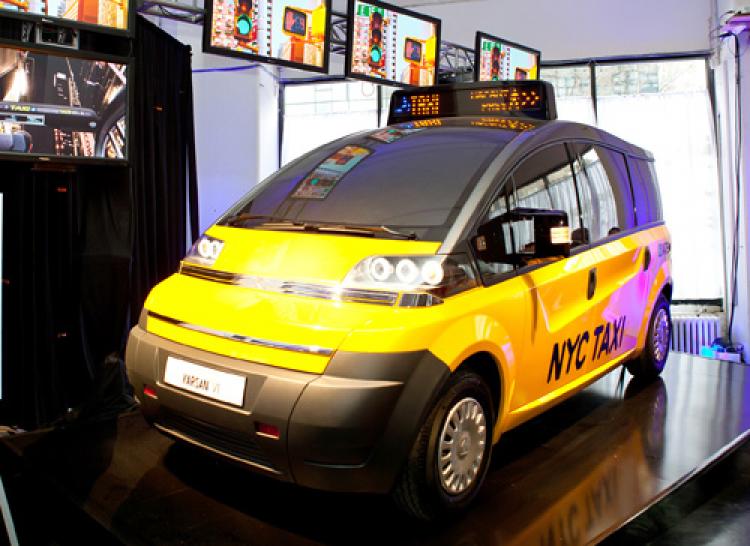NEW YORK— Karsan USA, one of the three finalists in the Taxi of Tomorrow competition, unveiled its design for New York City’s taxi fleet on Wednesday.
The city had called for cab makeover proposals in December 2009, inviting car manufacturers to create a taxicab specifically designed for New York City. Three companies were announced as finalists: Ford, Nissan, and Karsan. The winning design will manufacture and service the city’s taxi fleet for a decade.
Karsan’s proposed taxi features a panoramic glass roof, thereby allowing travelers to take in views of the city. It also boasts four-passenger seating and a built-in ramp for wheelchair access. The taxi’s easily accessible rear engine box can hold different types of engines—including hybrid, electric, and gas—thus enabling low-cost maintenance.
The Karsan cab was inspired by New York City, said Tolga Kaan Donanicioiglu, the company’s design team manager. The vehicle’s straight lines were inspired by Manhattan’s grid, and the curved roof was inspired by round city icons like Columbus Circle and the Guggenheim Museum, he explained.
“This vehicle has been designed from scratch,” said Jan Nahum, Karsan’s executive director. “The shape would be perfect for New York City,” he added.
The design focused on accessibility, Nahum said, noting that there is enough room in the taxi for a wheelchair-bound passenger to sit comfortably along with four other people. This is meant “to make their [wheelchair-bound passengers’] journey as enjoyable as the journey of other passengers,” he said.
Although the Americans with Disabilities Act mandates for public transportation to be accessible to people with mobility impairments, currently only some of the city’s cabs are wheelchair accessible.
The driver’s area of the Karsan cab also received special attention in the design process. The driver of the new taxi model does not share space with passengers and has ample space to keep his or her belongings in an orderly manner.
New York City’s taxi fleet is managed by private companies, not by the city. The Taxi and Limousine Commission requires that cab operators choose vehicles from several different models. Ford’s gasoline-powered Crown Victoria is currently the most common model; however, the automaker plans to stop producing it later this year.
The city had called for cab makeover proposals in December 2009, inviting car manufacturers to create a taxicab specifically designed for New York City. Three companies were announced as finalists: Ford, Nissan, and Karsan. The winning design will manufacture and service the city’s taxi fleet for a decade.
Karsan’s proposed taxi features a panoramic glass roof, thereby allowing travelers to take in views of the city. It also boasts four-passenger seating and a built-in ramp for wheelchair access. The taxi’s easily accessible rear engine box can hold different types of engines—including hybrid, electric, and gas—thus enabling low-cost maintenance.
The Karsan cab was inspired by New York City, said Tolga Kaan Donanicioiglu, the company’s design team manager. The vehicle’s straight lines were inspired by Manhattan’s grid, and the curved roof was inspired by round city icons like Columbus Circle and the Guggenheim Museum, he explained.
“This vehicle has been designed from scratch,” said Jan Nahum, Karsan’s executive director. “The shape would be perfect for New York City,” he added.
The design focused on accessibility, Nahum said, noting that there is enough room in the taxi for a wheelchair-bound passenger to sit comfortably along with four other people. This is meant “to make their [wheelchair-bound passengers’] journey as enjoyable as the journey of other passengers,” he said.
Although the Americans with Disabilities Act mandates for public transportation to be accessible to people with mobility impairments, currently only some of the city’s cabs are wheelchair accessible.
The driver’s area of the Karsan cab also received special attention in the design process. The driver of the new taxi model does not share space with passengers and has ample space to keep his or her belongings in an orderly manner.
New York City’s taxi fleet is managed by private companies, not by the city. The Taxi and Limousine Commission requires that cab operators choose vehicles from several different models. Ford’s gasoline-powered Crown Victoria is currently the most common model; however, the automaker plans to stop producing it later this year.







Friends Read Free